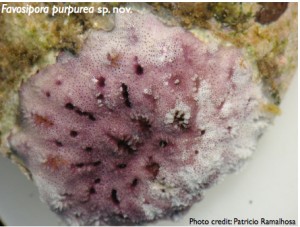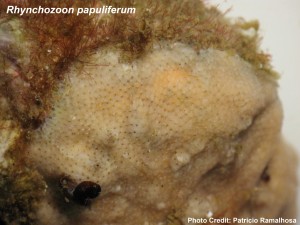by Kristen Minogue
Since he began surveying the waters of Madeira two years ago, João Canning-Clode has discovered a new invasive species almost every month. The archipelago off the coast of Portugal is a hot spot for biodiversity, especially for bryozoans – “moss animals” that often cover rocks, piers and other artificial substrates. But he didn’t anticipate finding a completely new species, let alone two.
Bryozoans are easy to mistake for plants or corals from a distance. Some resemble moss as they form encrusting colonies on underwater rocks. Others form branching, bush-like colonies that look more like algae or corals. Up close, though, a single colony can contain millions of individual, tube-shaped zooids. The zooids support each other. But break a piece off, and a single zooid can start a new colony of its own.
The team named the new species Favosipora purpurea (for its pinkish-purple color) and Rhynchozoon papuliferum (for its special triangular-shaped zooids). In this Q&A, Canning-Clode, a research associate with the Smithsonian Environmental Research Center, details the dual discovery published this month.
What makes bryozoans so cool?
Canning-Clode: They’re beautiful organisms. When we are sampling for surveys, this group of animals is usually the most abundant, and they have striking colors….And they’re very opportunistic. As soon as they see an empty spot, they immediately start growing. And sometimes they even grow on top of other species and even on top of other bryozoans. This phenomenon, it’s called epibiosis, when an animal actually grows on top of another one. And bryozoans are known and very peculiar for that.
When you survey in Madeira, you’re looking for non-native species. Did you expect to find something brand new, or was it a complete surprise?
It was a little bit of a surprise. It doesn’t mean these two species weren’t there. It means more that nobody was looking. And now we are increasing the sampling effort. We are doing a lot of samplings in the context of our monitoring surveys, and maybe we’ll find more.
How did you discover them?
Canning-Clode: A colleague of mine, the second author of this paper, Manfred [Kaufmann], he was diving with another colleague and he took some pictures of fish and algae. And I saw this pink bryozoan on the background of this picture. And I said, well, this is something different. I’ve never seen this before. So we went diving again the following week and collected some samples. And we sent them to this expert, who is based in Vienna, Austria, Javier Souto….
With my naked eye, I just spotted three species [in the samples]. And with the stereo microscope and later with the scanning electron microscope, Javier found eight species. So initially, I only sent these samples because I spotted the pink, colorful Favosipora purpurea. I did not spot the Rhynochozoon papuliferum. This was an addition. And only with the help of the [scanning electron] microscope we were able to find these guys.
How common are these new species in Madeira?
Canning-Clode: I can tell you [Favosipora] is a very common bryozoan now. In a book from 1996, I spotted, I think it is this bryozoan, in the back of a picture. So there is a picture where you see a fish common here in Madeira, and there is this bryozoan in the back, and the author actually says, “unidentified bryozoan.” And I’m pretty sure it’s this one, because of the pink color and the texture, it seems it’s this one. And after finding this new species, we went snorkeling and diving. We’ve spotted this already several times in different places.
So the Favosipora, I think it’s quite abundant right now. It doesn’t mean it was not here before. It means on one side, people were not looking for it, and there were not many people working on these organisms in particular.
You found another bryozoan, Beania maxilladentata, that was only seen in Brazil before now. Could it be an invasive species, or is it also native to Madeira?
Canning-Clode: We are not talking about invasive species right now. It’s hard to tell you if they were here before….Because it was described for Brazil first, that does not mean it came from there. We could argue that it could come from Brazil to Madeira because it was described first in Brazil, but why not the opposite? We are not sure. Again, because we only found it now, it does not mean that the species was not there before.
The discovery was published in the March 3 isssue of the journal Zootaxa. To learn about invasive bryozoans and find out which ones are near you, check out the NEMESIS database of SERC’s Marine Invasions Lab.





Wow. I’m really glad you petosd this. Bryozoans are one of those thing in the intertidal I had SUCH a tenuous grasp upon.You see something flat that clings to a rock but is clearly not the rock. So, what is it? Is that encrusting algae? Bryozoan? Some kinda flat sponge layer (we had those, too)??Animal? Vegetable? Mineral? I DON’T KNOW!!Seeing it with their little “faces” helps a lot. =)